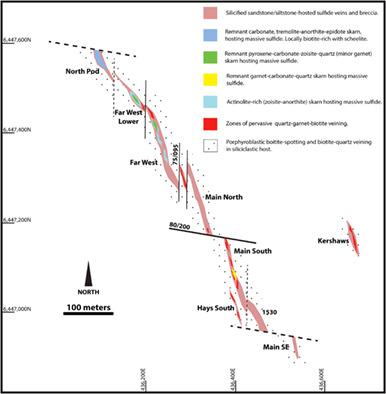当前位置:
X-MOL 学术
›
Resour. Geol.
›
论文详情
Our official English website, www.x-mol.net, welcomes your
feedback! (Note: you will need to create a separate account there.)
The Hera orebody: A complex distal (Au–Zn–Pb–Ag–Cu) skarn in the Cobar Basin of central New South Wales, Australia
Resource Geology ( IF 1.1 ) Pub Date : 2021-06-09 , DOI: 10.1111/rge.12262 Joel A. Fitzherbert 1 , Adam R. McKinnon 2 , Phillip L. Blevin 1 , Kathryn Waltenberg 3 , Peter M. Downes 1 , Corey Wall 4 , Erin Matchan 5 , Huiqing Huang 6
Resource Geology ( IF 1.1 ) Pub Date : 2021-06-09 , DOI: 10.1111/rge.12262 Joel A. Fitzherbert 1 , Adam R. McKinnon 2 , Phillip L. Blevin 1 , Kathryn Waltenberg 3 , Peter M. Downes 1 , Corey Wall 4 , Erin Matchan 5 , Huiqing Huang 6
Affiliation

|
The Hera Au–Pb–Zn–Ag deposit in the southeastern Cobar Basin of central New South Wales preserves calc-silicate veins and remnant sandstone/carbonate-hosted skarn within a reduced anchizonal Siluro-Devonian turbidite sequence. The skarn orebody distribution is controlled by a long-lived, basin margin fault system, that has intersected a sedimentary horizon dominated by siliciclastic turbidite, with lesser gritstone and thick sandstone intervals, and rare carbonate-bearing stratigraphy. Foliation (S1) envelopes the orebody and is crosscut by a series of late-stage east–west and north–south trending faults. Skarn at Hera displays mineralogical zonation along strike, from southern spessartine–grossular–biotite–actinolite-rich associations, to central diopside-rich–zoisite–actinolite/tremolite–grossular-bearing associations, through to the northern most tremolite–anorthite-rich (garnet-absent) association in remnant carbonate-bearing lithologies and sandstone horizons; the northern lodes also display zonation down dip to garnet present associations. High-T, prograde skarn assemblages rich in pyroxene and garnet are pervasively replaced by actinolite/tremolite–biotite-rich retrograde skarn which coincides with the main pulse of sulfide mineralization. The dominant sulfides are high-Fe–Mn sphalerite–galena–non-magnetic high-Fe pyrrhotite–chalcopyrite; pyrite, arsenopyrite; scheelite (low Mo) is locally abundant. The distribution of metals in part mimics the changing gangue mineralogy, with Au concentrated in the southern and lower northern lode systems and broadly inverse concentrations for Ag–Pb–Zn. Stable isotope data (O–H–S) from skarn amphiboles and associated sulfides are consistent with magmatic (or metamorphic) water and sulfur input during the retrograde skarn phase, while hydrosilicates and sulfides from the wall rocks display comparatively elevated δD and mixed δ34S consistent with progressive mixing or dilution of original magmatic (or metamorphic) waters within the Hera deposit by unexchanged waters typical of low latitude (tropical) meteoritic waters. High precision titanite (U–Pb) and biotite (Ar–Ar) geochronology reveals a manifold orebody commencing with high-T skarn and retrograde Pb–Zn-rich skarn formation at ≥403 Ma, Au–low-Fe sphalerite mineralization at 403.4 ± 1.1 Ma, foliation development remobilization or new mineralization at 390 ± 0.2 Ma followed by thrusting, orebody dismemberment at 384.8 ± 1.1 Ma and remobilization or new mineralization at 381.0 ± 2.2 Ma. The polymetallic nature of the Hera orebody is a result of multiple mineralization events during extension and compression and involving both magmatic and likely formational metal sources.
中文翻译:

Hera 矿体:澳大利亚新南威尔士州中部 Cobar 盆地的复杂远侧(Au-Zn-Pb-Ag-Cu)矽卡岩
位于新南威尔士州中部 Cobar 盆地东南部的 Hera Au-Pb-Zn-Ag 矿床保留了钙硅酸盐脉和残余砂岩/碳酸盐岩的矽卡岩,位于减少的近地带志陆-泥盆纪浊积岩序列中。矽卡岩矿体分布受长寿命盆地边缘断层系统控制,该断层系统与以硅质碎屑浊积岩为主的沉积层相交,具有较少的砂岩和厚砂岩间隔,以及稀有的含碳酸盐地层。叶状体(S1)包围矿体,被一系列晚期东西向和南北向断层横切。赫拉的矽卡岩沿走向显示出矿物学分带,从南部的锰铝榴石-钙榴石-黑云母-富含阳起石的组合,到中央富含透辉石-黝帘石-阳起石/透闪石-含菱镁矿的组合,直至最北端的含碳酸盐岩性和砂岩地层中的最北端富含透闪石-钙长石(不含石榴石)的组合;北部矿脉也显示出分带向下倾角到石榴石目前的关联。富含辉石和石榴石的高温顺行矽卡岩组合普遍被阳起石/透闪石-富含黑云母的逆行矽卡岩所取代,这与硫化物矿化的主要脉搏相吻合。主要硫化物为高铁-锰闪锌矿-方铅矿-非磁性高铁磁黄铁矿-黄铜矿;黄铁矿,毒砂;白钨矿(低钼)是当地丰富的。金属的分布部分模仿了脉石矿物学的变化,金集中在南部和北部矿脉系统中,而银-铅-锌的浓度大致相反。34 S 与 Hera 矿床内原始岩浆(或变质)水被低纬度(热带)陨石水典型的未交换水逐渐混合或稀释一致。高精度钛铁矿 (U-Pb) 和黑云母 (Ar-Ar) 年代学揭示了一个多形矿体,开始于 ≥403 Ma 的高 T 矽卡岩和逆行富含 Pb-Zn 矽卡岩的形成,403.4 ± 金-低铁闪锌矿矿化1.1 Ma,在 390±0.2 Ma 处叶理发育再活化或新矿化,随后在 384.8±1.1 Ma 处逆冲、矿体解体,在 381.0±2.2 Ma 处再活化或新矿化。Hera 矿体的多金属性质是在伸展和压缩过程中多次矿化事件的结果,涉及岩浆和可能的地层金属源。
更新日期:2021-06-09
中文翻译:

Hera 矿体:澳大利亚新南威尔士州中部 Cobar 盆地的复杂远侧(Au-Zn-Pb-Ag-Cu)矽卡岩
位于新南威尔士州中部 Cobar 盆地东南部的 Hera Au-Pb-Zn-Ag 矿床保留了钙硅酸盐脉和残余砂岩/碳酸盐岩的矽卡岩,位于减少的近地带志陆-泥盆纪浊积岩序列中。矽卡岩矿体分布受长寿命盆地边缘断层系统控制,该断层系统与以硅质碎屑浊积岩为主的沉积层相交,具有较少的砂岩和厚砂岩间隔,以及稀有的含碳酸盐地层。叶状体(S1)包围矿体,被一系列晚期东西向和南北向断层横切。赫拉的矽卡岩沿走向显示出矿物学分带,从南部的锰铝榴石-钙榴石-黑云母-富含阳起石的组合,到中央富含透辉石-黝帘石-阳起石/透闪石-含菱镁矿的组合,直至最北端的含碳酸盐岩性和砂岩地层中的最北端富含透闪石-钙长石(不含石榴石)的组合;北部矿脉也显示出分带向下倾角到石榴石目前的关联。富含辉石和石榴石的高温顺行矽卡岩组合普遍被阳起石/透闪石-富含黑云母的逆行矽卡岩所取代,这与硫化物矿化的主要脉搏相吻合。主要硫化物为高铁-锰闪锌矿-方铅矿-非磁性高铁磁黄铁矿-黄铜矿;黄铁矿,毒砂;白钨矿(低钼)是当地丰富的。金属的分布部分模仿了脉石矿物学的变化,金集中在南部和北部矿脉系统中,而银-铅-锌的浓度大致相反。34 S 与 Hera 矿床内原始岩浆(或变质)水被低纬度(热带)陨石水典型的未交换水逐渐混合或稀释一致。高精度钛铁矿 (U-Pb) 和黑云母 (Ar-Ar) 年代学揭示了一个多形矿体,开始于 ≥403 Ma 的高 T 矽卡岩和逆行富含 Pb-Zn 矽卡岩的形成,403.4 ± 金-低铁闪锌矿矿化1.1 Ma,在 390±0.2 Ma 处叶理发育再活化或新矿化,随后在 384.8±1.1 Ma 处逆冲、矿体解体,在 381.0±2.2 Ma 处再活化或新矿化。Hera 矿体的多金属性质是在伸展和压缩过程中多次矿化事件的结果,涉及岩浆和可能的地层金属源。











































 京公网安备 11010802027423号
京公网安备 11010802027423号